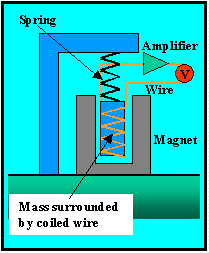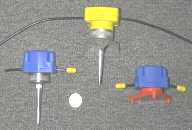Geophones by Tom Boyd Colorado School of Mines
 Contrary to what you might think,
geophones are remarkably simple (yet ingenious) devices. Like
gravity meters, the active element of the device consists of a mass hanging
on a spring. When the ground moves, the mass (because it has inertia) wants to
remain motionless. If you were watching the seismometer as the ground moved, it
would look like the mass itself was moving. But, in reality, you are moving with
the ground, and the mass is remaining motionless*.
Contrary to what you might think,
geophones are remarkably simple (yet ingenious) devices. Like
gravity meters, the active element of the device consists of a mass hanging
on a spring. When the ground moves, the mass (because it has inertia) wants to
remain motionless. If you were watching the seismometer as the ground moved, it
would look like the mass itself was moving. But, in reality, you are moving with
the ground, and the mass is remaining motionless*.
Now for the part that I really consider ingeneous. Wrapped around the mass is
a strand of wire. Surrounding the wire-wrapped mass is a magnet that is fixed to
the Earth. As the Earth moves, the magnet moves up and down around the mass. The
magnetic field of this moving magnet produces an electrical voltage in the wire.
This voltage can be amplified and recorded by a simple voltmeter. It is
relatively easy to show that the voltage recorded by the voltmeter is
proportional to the velocity (speed) at which the ground is moving**.
 Shown to the left is an example of a
geophone that is representative of those typically used in seismic refraction
and reflection work. A quarter is shown for scale. This particular seismometer
has had its side cut out so that you can see its working parts. The wire-
(copper wire in this case) wrapped mass can be clearly seen inside the geophone.
The spring connecting the geophone to the case can not be seen but is just above
the mass. The silver colored case just inside the blue plastic external case is
magnetized. The black wires coming out from either side of the blue case
transmit the variations in voltage to the recording system. The long silver
spike below the blue case is used to firmly attach the geophone to the ground.
This spike is pressed into the ground by stepping on the top of the geophone
until it is completely buried.
Shown to the left is an example of a
geophone that is representative of those typically used in seismic refraction
and reflection work. A quarter is shown for scale. This particular seismometer
has had its side cut out so that you can see its working parts. The wire-
(copper wire in this case) wrapped mass can be clearly seen inside the geophone.
The spring connecting the geophone to the case can not be seen but is just above
the mass. The silver colored case just inside the blue plastic external case is
magnetized. The black wires coming out from either side of the blue case
transmit the variations in voltage to the recording system. The long silver
spike below the blue case is used to firmly attach the geophone to the ground.
This spike is pressed into the ground by stepping on the top of the geophone
until it is completely buried.
 Different styles of geophone cases are
available for use in different environments. Several examples are shown to the
right. The geophone shown to the far right (the one without the spike), for
example, is designed for use on hard surfaces into which spikes can not be
pushed.
Different styles of geophone cases are
available for use in different environments. Several examples are shown to the
right. The geophone shown to the far right (the one without the spike), for
example, is designed for use on hard surfaces into which spikes can not be
pushed.
Geophones used in exploration seismology are relatively inexpensive. Costs
ranging from $75 to $150 per geophone are not uncommon. Although this cost per
geophone is small, remember that many (1000's) of geophones may be used in the
large reflection seismic surveys conducted for the petroleum industry.
Near-surface investigations are typically much smaller in scale, both in terms
of area covered and in terms of equipment needed. For a near-surface refraction
survey, one could use as few as twelve or as many as a hundred geophones.
Near-surface reflection surveys use only a moderately greater (24 to 150) amount
of geophones at any one time.
*Obviously, this is a simplification of what really happens. Because the
spring is not perfectly compliant, the mass does in fact move when the Earth
moves. It moves in a very complex fashion that can be relatively easily
quantified. For our purposes, however, we can make the assumption that the mass
remains motionless without loss of generalization.
**This type of geophone was first invented in 1906 by a prince of the Russian
empire by the name of B. B. Galitizin.
 Contrary to what you might think,
geophones are remarkably simple (yet ingenious) devices. Like
gravity meters, the active element of the device consists of a mass hanging
on a spring. When the ground moves, the mass (because it has inertia) wants to
remain motionless. If you were watching the seismometer as the ground moved, it
would look like the mass itself was moving. But, in reality, you are moving with
the ground, and the mass is remaining motionless*.
Contrary to what you might think,
geophones are remarkably simple (yet ingenious) devices. Like
gravity meters, the active element of the device consists of a mass hanging
on a spring. When the ground moves, the mass (because it has inertia) wants to
remain motionless. If you were watching the seismometer as the ground moved, it
would look like the mass itself was moving. But, in reality, you are moving with
the ground, and the mass is remaining motionless*.  Shown to the left is an example of a
geophone that is representative of those typically used in seismic refraction
and reflection work. A quarter is shown for scale. This particular seismometer
has had its side cut out so that you can see its working parts. The wire-
(copper wire in this case) wrapped mass can be clearly seen inside the geophone.
The spring connecting the geophone to the case can not be seen but is just above
the mass. The silver colored case just inside the blue plastic external case is
magnetized. The black wires coming out from either side of the blue case
transmit the variations in voltage to the recording system. The long silver
spike below the blue case is used to firmly attach the geophone to the ground.
This spike is pressed into the ground by stepping on the top of the geophone
until it is completely buried.
Shown to the left is an example of a
geophone that is representative of those typically used in seismic refraction
and reflection work. A quarter is shown for scale. This particular seismometer
has had its side cut out so that you can see its working parts. The wire-
(copper wire in this case) wrapped mass can be clearly seen inside the geophone.
The spring connecting the geophone to the case can not be seen but is just above
the mass. The silver colored case just inside the blue plastic external case is
magnetized. The black wires coming out from either side of the blue case
transmit the variations in voltage to the recording system. The long silver
spike below the blue case is used to firmly attach the geophone to the ground.
This spike is pressed into the ground by stepping on the top of the geophone
until it is completely buried.  Different styles of geophone cases are
available for use in different environments. Several examples are shown to the
right. The geophone shown to the far right (the one without the spike), for
example, is designed for use on hard surfaces into which spikes can not be
pushed.
Different styles of geophone cases are
available for use in different environments. Several examples are shown to the
right. The geophone shown to the far right (the one without the spike), for
example, is designed for use on hard surfaces into which spikes can not be
pushed.